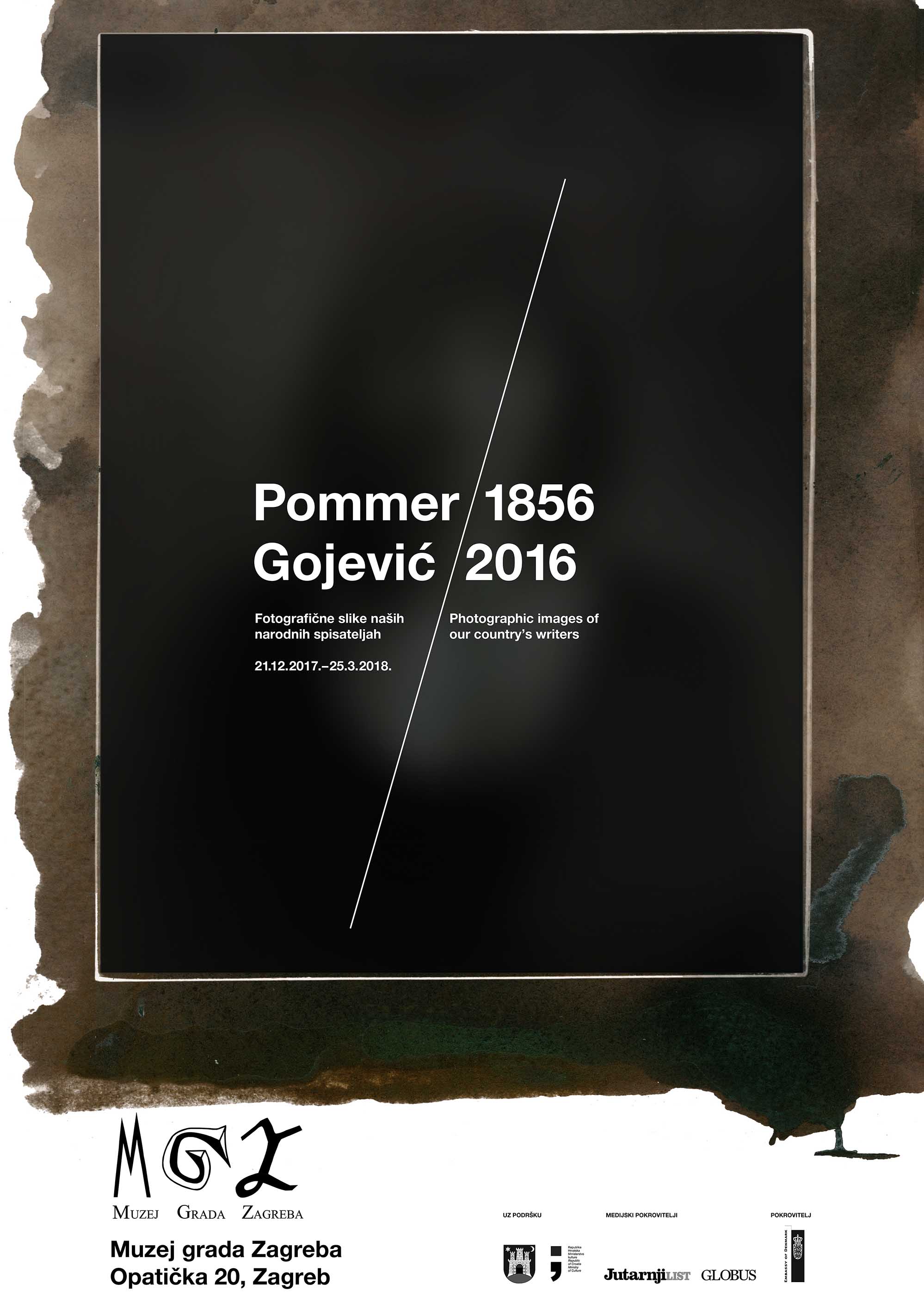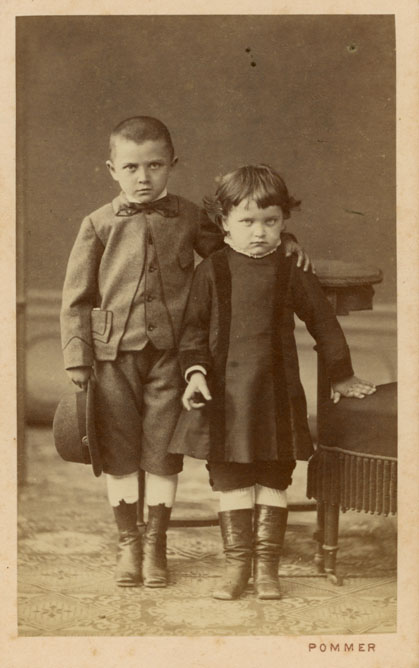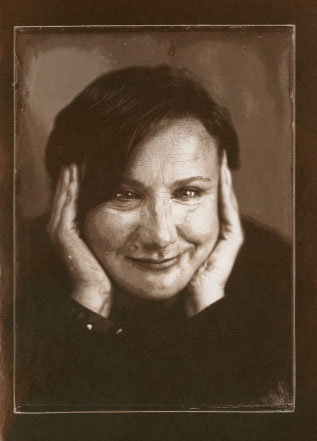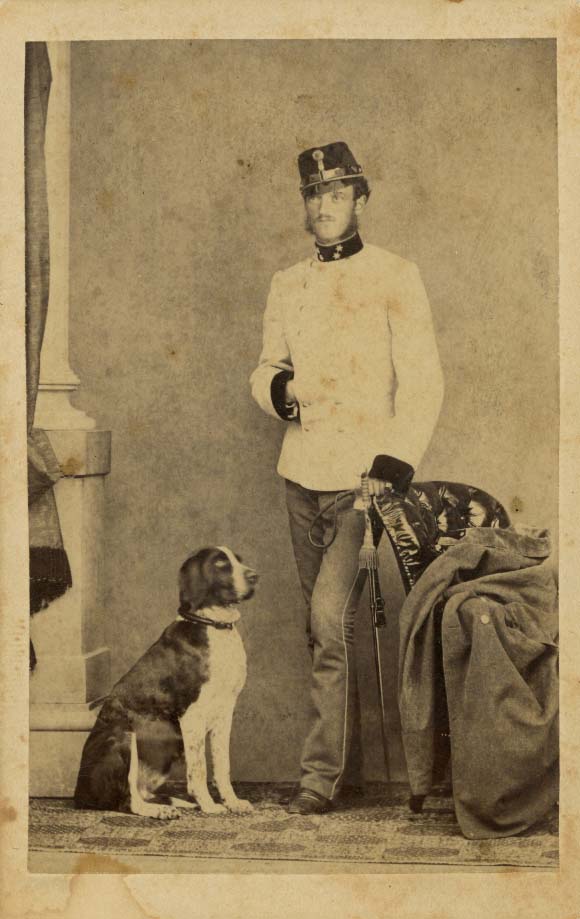Pommer 1856: Gojević 2016 Photographic pictures of our vernacular authors
Exhibition created by Dr Hrvoje Gržina (Croatian State Archives) and Iva Prosoli (Zagreb City Museum)
Curators: Dunja Nekić (Museum of Arts and Crafts), Iva Prosoli (Zagreb City Museum), Dubravka Zaninović Stančec (Zagreb City Museum)
Set design, visual identity and printed matter by Bachrach and Krištofić
The Embassy of the Kingdom of Denmark in the Republic of Croatia has kindly acted as patron of the exhibition
 The exhibition Pommer 1856 / Gojević 2016 Photographic pictures of our vernacular authors is the outcome of a collaborative venture involving Zagreb City Museum, the Croatian State Archives and the Museum of Arts and Crafts, combining the work of contemporary photographer Robert Gojević with a 19th century photographic artist, Franz (or Franjo) Pommer.
The exhibition Pommer 1856 / Gojević 2016 Photographic pictures of our vernacular authors is the outcome of a collaborative venture involving Zagreb City Museum, the Croatian State Archives and the Museum of Arts and Crafts, combining the work of contemporary photographer Robert Gojević with a 19th century photographic artist, Franz (or Franjo) Pommer.
The first part of the exhibition is devoted to Franz Pommer, an incomer from Denmark and the first Zagreb photographer ever to have a registered studio, as well as the author of the first photographic project ever carried out in Croatia, Photographic pictures of our vernacular authors of 1856. Brought together at the show are selected photographs of Franz Pommer kept in the three institutions, the fundamental concept of the exhibition following the research of Dr Hrvoje Gržina, senior archivist and head of the central photographic laboratory in the Croatian State Archives. Pommer’s work is presented chronologically through three periods of his work: the early period, 1854 to 1860, from the opening of his studio and the early pieces; the central period, 1861 to 1874, in which Pommer was actively at work in the studio in Vijećnićka Street in the Upper Town, from which the greatest number of extant photos derive; and the late period, 1875 to 1879, which covers the work of the by now well-reputed photographer from his move to a studio in Ilica to his death. By the selection of photographs within the three units so set up, an endeavour has been made to present the basic technical, formal, thematic, generic and stylistic characteristics of Pommer’s oeuvre.
A parallel analysis of photos from the three institutions has enabled, since the sample is so much the greater, a much more precise dating of individual shots than was previously possible.
Particularly featured in the exhibition are photographs that were created as part of the Photographic pictures of our vernacular authors project, from which the exhibition has taken its name; also shown is the Unveiling of the monument to Jellačić Ban in Zagreb on December 16, 1866, one of the few Pommer pictures to have been taken outside the studio, and one of the first reportage photos taken in Croatia.

The Unveiling of the Monument to Jellačić Ban in Zagreb, December 16, 1866, albumen print, December 16, 1866.
Part two of the exhibition is a dedication to Pommer by contemporary photographer Robert Gojević, who, taking his cue from Pommer, has shot photos of fifteen contemporary Croatian writers. He took the photographs using the wet-collodion process and reproducing them as prints on salted paper, that is, reinterpreting a photography procedure hypothesised to have been used in the photographing of the vernacular authors. In Gojević’s project, the role of editor was played by Kruno Lokotar.
All the photographs shown are originals: the photographs on salted paper, the albumen photos and the chromotypes (Pommer) and ambrotypes and photographs on salted paper (Gojević), for the sake of the easier understanding of the technical givens of the photographic medium, and the characteristics that have stemmed from them, in both the 19th century and today.

Two children, albumen print, 1875-1879
The exhibition is expanded in its catalogue, which is a link between the two authors, between whom there are in fact one hundred and fifty years. As well as expert and academic papers about Franz Pommer and Robert Gojević, it covers literary texts of contemporary Croatian writers that they have devoted to their portraitist. The catalogue has been reviewed by Dr Marija Tonković and Dr Lovorka Magaš Bilandžić.

Pavao Hatz, Mayor of Zagreb, albumen print, 1862.
Excerpt from the review of Dr Marija Tonković
The joint work of the three institutions aims at a quantitative and qualitative contribution to their holdings of the work of Franz Pommer. It identifies and re-evaluates the medium and his techniques, and thus indirectly the cultural and technological level of the milieu, enriching experience with aesthetic and documentary contents.
Hrvoje Gržina critically reconsiders previous knowledge. In a complex approach, he shows that photography, thanks to its immanent properties, is permeable to every worldview and sentiment as well as social need. He has included a series of methods and techniques for assembling data, relying on a qualitative methodology. By an outstanding reconstruction of Pommer’s biography, origins and life circumstances, he has fixed his place and values in a temporal and spatial set. He has accordingly contributed importantly to putting the author and his works back into their pre-museum life and real context.
Iva Prosoli takes up the issue of the objective reality of Pommer’s work. She shows Pommer’s studio as a paradigmatic example of the style of the time, in other words of the recognisable manner of the photographic practice of the period. In a well-informed and readable manner she achieves a balance between strictly art historical interpretation and a cultural history grounding. She has reconstructed an essential segment of the culture of Zagreb and set up correlations with identified and authentic European patterns.
Dubravka Zaninović Stančec and Dunja Nekić have attentively chosen, studied and presented Pommer’s works from the museum collections, with an account of the formation and profiling of the holdings through systematic collecting.
The second part of the exhibition is a kind of counterpoint to Pommer’s exhibits, in which Robert Gojević, from the 21st century, sets up a dialogue with the bygone author. On the lines of post-modernism, meta-reflection and the subjective documentary he recreates Pommer as privileged interlocutor. He experiences the rare extant portraits of Croatian writers like remains of the maps from Borges’ story “On Exactitude in Science”. Transferring facts and figures into the message, through fifteen portraits of writers, contemporaries of ours, taken on a wet-collodion plate he produces a tribute to Pommer, a natural allegorical simulacrum.

Dorta Jagić, photographic print on salted paper, 2016
Excerpt from the review of Dr Lovorka Magaš Bilandžić
The authors of the articles, from several angles and applying various methodological approaches, analyse the work and contribution of Franz Pommer. They revise and supplement previous knowledge about the work and life of this first settled Zagreb photographer, considering his presence in the leading heritage institutions and contextualising the project called Photographic pictures of our vernacular authors (1856) in a broader European framework. Pommer’s work is read in the context of this two-part exhibition from a contemporary perspective as well and re-interpreted in a series of portraits by photographer Robert Gojević who, using a historical technique, took pictures in 2016 of fifteen contemporaries – leading figures of the Croatian writing scene – and created a kind of photographic tribute to Pommer, to his gallery of writers and to historical photographic processes. The exhibition Pommer 1856 / Gojević 2016 Photographic pictures of our vernacular authors is an interesting exhibition project that by juxtaposing the two photographers –exhibiting Pommer’s original pictures and Gojević’s photographs taken with the use of a historical photographic process, accompanied by short texts by the contemporary writers portrayed – in a multidisciplinary way and from a contemporary angle observes and makes current the work of one of the pioneers of photography in Croatia.

Unknown soldier with dog, albumen print, 1861

